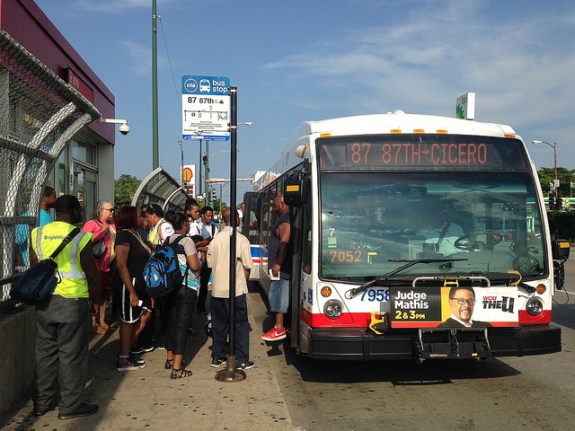Today the Active Transportation Alliance released a new report that analyzes why CTA bus use has dropped in recent years and recommends low-cost ways to shorten travel times and boost ridership. They note that fewer Chicagoans riding the bus means more driving, congestion, and pollution. And as people who can afford to do so abandon buses, revenue decreases and service deteriorates, which disproportionately impacts residents of lower-income communities.
For these reasons, it’s important for us to address this troubling trend through strategies like dedicated bus lanes, faster boarding, and transit signal prioritization. The report also calls for fair enforcement of bus-only lanes, and reforming the regulation of ride-hailing services like Uber and Lyft, which recent studies show are reducing transit use, especially bus ridership.
The report, funded by the TransitCenter foundation, was written with input from the CTA, the Chicago Department of Transportation, and the private sector, as well thousands of straphangers. Its ideas are endorsed by a coalition that includes nine other community organizations and nonprofits.

The study notes that while more than half of CTA trips are made by bus, from 2015 to 2016 bus ridership in Chicago fell by more than 15 million rides (5.8 percent). Since 2012, bus ridership has declined by more than 17 percent, and it’s dropped by more than 21 percent since 2008, when the Great Recession hit.
“The next several years present an opportunity to make timely, cost-effective improvements to bus service while continuing to pursue long-term investments in rail modernization and expansion,” the report states. “Upgrading bus service requires leadership from elected officials and city agencies, and a strong and unified push from advocates and community leaders.”
The study blames the drop in ridership on underinvestment in bus service, falling gas prices, the rise of new transportation options like ride-hailing, and an increasing number of workplaces and developments sprawled across the suburbs. Falling gas prices have also led to more driving, and as congestion has gotten worse over the last decade bus speeds have decreased.
To combat this development, the report recommends the following strategies:
- Create at least 50 miles of dedicated bus lanes and other infrastructure to give high-ridership routes priority
- Transit signal prioritization – using technology that shortens reds or extends greens to help buses travel more efficiently
- Prepaid, multi-door boarding
While Chicago has already piloted some of these improvements on the Loop Link and Jeffery Jump corridors, as well as a few bus stops and train stations, Active Trans for expanding these improvements citywide sooner than later, which will require some political muscle.
This report focuses on six of the busiest routes in the system, with some of the highest potential for improvements: #4 Cottage Grove, #8 Halsted, #53 Pulaski, #66 Chicago, #79 79th, and #80 Irving Park. Each of these lines serves millions of customers annually and travels to many destinations in diverse communities, but they’ve seen a drop in ridership.
The report also includes the following policy recommendations and action items:
- CDOT and CTA develop plan for transit priority streets within two years that includes at least 50 miles of new bus lanes
- Get a new state law passed allowing photo enforcement of bus lanes
- Incentivize purchase of CTA multi-day passes, possibly by lowering prices and passing a state law requiring Chicagoland companies with 25 or more employees to offer the transit benefit program
- Establish a new local dedicated revenue stream to fund transit improvements and expansion
- Push for more data sharing and analysis of ride-hailing trips though a city ordinance requiring anonymized trip data to be made public
We'll provide some analysis on the report's ideas in the near future. In the meantime check out the report yourself and let us know what you think in the comments.





